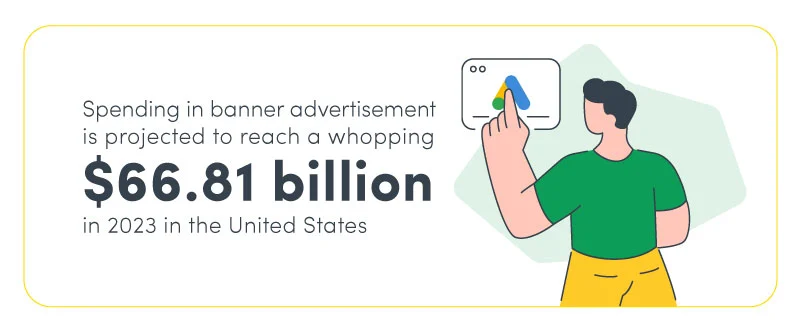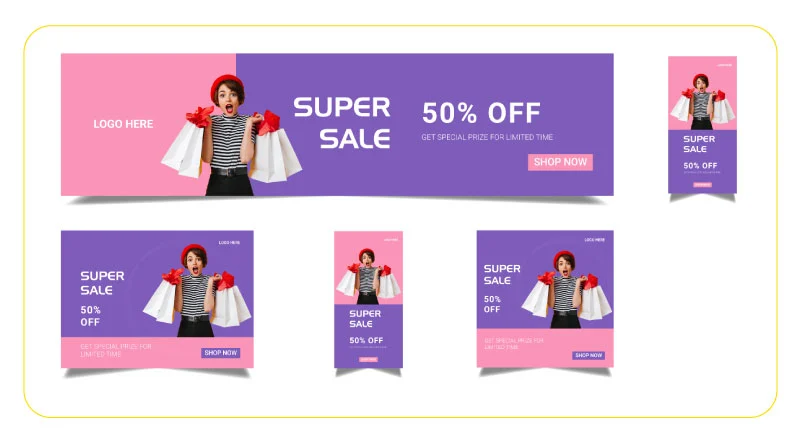Looking for an effective way to attract prospects and target your different audience segments? Well, Google Ads, and specifically, Google Display Ads is a marketing powerhouse that enables you to find customers and boost your revenue in a cost-effective and hassle-free manner. Digital display advertising already has a massive market and countless businesses all around the world spend billions of dollars on it. Display advertising provides all the benefits you would expect from a modern digital advertising method:

Several large platforms with tons of advanced features and automated systems that take care of much of the manual work for you and provide lots of performance analytics data to optimize your campaigns to the fullest. Google Ads is a brilliant example, But just like any other marketing tool, you need to get the full grasp of it and learn about the best techniques to get the most bang for your buck. We’ve gathered Google Display best practices to help you skip the trial and error phase and get desired results right away with your display campaigns.
Google Display Network; What is it?
Display advertising is the digital equivalent of billboards and ad posters of the real world. As one of the simplest ways to promote a business, display advertising found its way to the virtual world fairly quickly. All that websites had to do was making room for banners on their pages and wait for clients to reserve them for their ads. Consequently, display advertising has been around in the digital advertising for as long as we can remember, but nowadays, modern display advertising has evolved to keep up with the needs of businesses and customers. Now, we’re in the era of massive advertising networks like the Google Display Network which is at the center of all Google Display practices we’re going to talk about.

The old way of running display campaigns is simply not feasible today. The digital advertising industry has turned into a gigantic money-making machine, containing millions of businesses around the world constantly looking for new and better ways to reach new customers and expand their clientele. To handle this massive demand for ad opportunities, large integrated networks have emerged that let advertisers run campaigns across millions of websites, apps, web pages, and services without having to negotiate with each one individually.
The GDN is arguably the best and biggest digital display advertising networks in the world right now. It covers over two million websites and apps and packs a state-of-the-art advertising suite with tons of features all created to streamline the process of finding and converting customers easier and more cost-efficient for you. Display advertising on this platform is highly automated, both in terms of finding and optimizing the audiences of campaigns and creating the ads themselves. It also provides advertisers with tons of actionable data and performance analysis to help them optimize their display campaigns even further.
Should you use Google Display?
Even though you and countless other people might find display ads annoying, they’re still a sweetheart to the global digital advertising market. Spending in banner advertisement is projected to reach a whopping $66.81 billion in 2024 in the United States. So, don’t underestimate the power of display advertising.
Now as to why you should trust Google with your display ads, GDN is particularly great for prospecting and building brand awareness without emptying your pocket. It’s a visual experience that has a stronger impact on users in the long run compared to other popular ad formats like search ads. The average click-through rate for display advertising is considerably lower than search ads, meaning people are not going to click on your ads as much as you might expect, but that’s not necessarily a bad thing when you consider how display ads have a different function than search ads. Display ads appear on places like websites and apps, where they’re not the point of focus, but more like secondary reminders that indirectly introduces your brand to viewers, or remind them of you and what you offer.

Long gone are the days when display ads used to cover entire web pages with flashing lights and annoying animations. This is the age of programmatic display advertising, where you bid on spots across a large network instead of negotiating with website owners over poorly designed and placed banner ads. The overall display ad experience has massively improved over the years, both for advertisers and users.
Your average cost-per-click is lower with GDN since you’re no longer in fierce competition with advertisers over keywords. You can reach a wider audience and work with more than just a title and description. Having more control over branding is a strong advantage for Google Display advertising and you’ll have higher chance of making an impact on viewers.
The best Google display advertising practices
Now, of you’ve decided to try advertising on GDN in your marketing efforts, there are a few tips and practices you could follow to maximize the impact of your ads and boost results without having to learn them by expensive and time-consuming personal experiences.
Go with responsive ads first
Google gives you two options to create your display ads. You can use the responsive ads method, where your provide Google with a few assets and it will generate ads based on them. Or you could do it manually and provide images in all sizes and formats for different placements.

If you’re a newbie or don’t have enough resources for ad design, we strongly recommend using responsive ads. Although you’ll have less control over your assets, it’s extremely easy, cost-effective, and quick to create and setup.
Practices for creatives
One of the best features of Google Display is automatic ad generation using provided assets. The engine optimally combines the assets to create ads that fit into different placements, but you still have to provide these assets to it. Visual design is the most important aspect of display ads, so try the following tried and tested practices to maximize the impact:
- Include your logo in the design. A primary objective of display advertising is building brand awareness and making people remember your name. How is anyone going to remember your brand when they don’t even know your name?
- Keep the design in line with your visual identity. We strongly recommend developing a memorable and eye-pleasing visual identity that suits your brand. But remember that your display ads must be an extension of your visual language. Use your brand colors, fonts, and graphics when designing your ads.
- Create both static and animated banners. Designing animated ads is a bit more intricate and expensive, but it’s definitely worth it since the results are considerably better than static ads. However, you should be careful not to create your animations too distracting or annoying. Again make sure to use your logo and brand guidelines for visual design and put your CTA in the last frame.
- Keep the clutter to a minimum. Your ads don’t have to be filled with texts and color and graphics to attract attention. In fact, the more cluttered your ads, the more distracting they get. Keep your design simple and focus on a clear core message.
- Support your message with a thoughtful design. Simply looking beautiful isn’t the sole purpose of your display ads. You should incorporate strong and mindful imagery to boost the impact of your message and make it memorable. Remember that “Beautiful” is not equal to “Complex”. Sometimes a highly minimalistic designs works better than intricate ones. A nice way to tweak your designs is getting inspirations from top ads using a Google display ads spy tool.
Run remarketing display campaigns
Converting a potential customer to an actually customer is a process. For display advertising, this process is more time and energy-consuming since you start at higher stages of your marketing funnel by introducing your brand to people who might be interested in it. Contrary to paid search ads where you target that audience that are actively looking for something you offer, display advertising is about prospecting AND remarketing. Unfortunately, the latter is often neglected when developing a Google Display Ads strategy.

Remarketing puts focus on the people who are already aware of your brand and even considered buying from you at one point. Converting these people is way easier than cold audiences. All you need to do is reminding of the interest they had in your brand, and give them the extra push they need to become your customers. Google Display works exceptionally well for remarketing and enables you to target your previous website visitors, subscribers, leads, etc. You remarketing audience segments should be totally separate from your new prospect segments to avoid targeting people with material brand awareness ads.
Google Shopping Ads best practices
In addition to Google Display best practices, it’s important to consider effective strategies for Google Shopping Ads to maximize your advertising efforts. When it comes to Google Shopping Ads best practices, the first thing to learn is optimizing your product feed is key. Start by ensuring that your product titles are clear, concise, and include relevant keywords. Provide accurate and detailed product descriptions, highlighting key features, benefits, and unique selling points. Including high-quality product images from multiple angles can significantly increase your click-through rates.
Conclusion
There you go. Here are some of the most effect tips and practices to enhance your Google Display campaigns and make the best use of what the platform offers. Display advertising is a visual experience, so at the end if this article, we would like to recommend trying and testing different creatives and designs to find the ones that best resonate with your audience.
FAQs
How do I optimize Google display?
Exclude websites and placements that are not related to your brand or your product/service. Create high-quality and eye-catching assets that align with your brand’s visual design guidelines and support the core message you’d like to send with your ads. Put clear CTAs on your ads, and make sure to use your logo too.
What makes a good Google display ad?
A good Google display ad isn’t necessarily filled with attention-grabbing colors and texts and graphics. The primary point of focus of a good display ad is the message it’s going to send. Everything, from design to copy, should be at the service of this message.
What are the best sizes for Google display ads?
Landscape image (1.91:1): 1200 x 628 | Square (1:1): 1200 x 1200 | Portrait (9:16): 900 x 1600







 Facebook Ads Spy Tool
Facebook Ads Spy Tool TikTok Ads Spy Tool
TikTok Ads Spy Tool